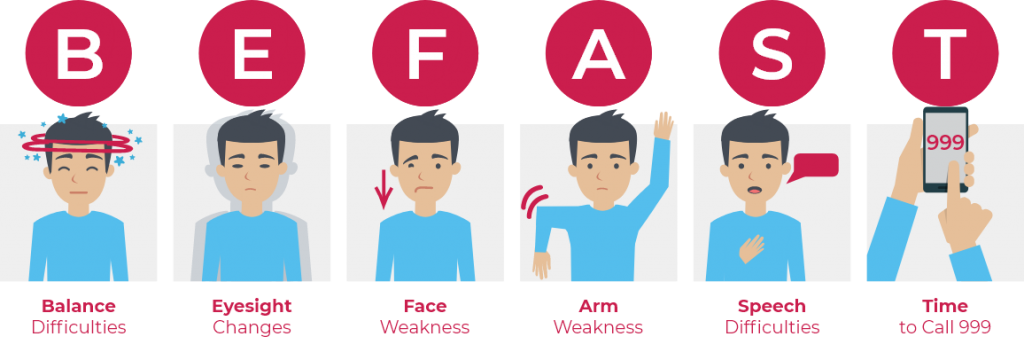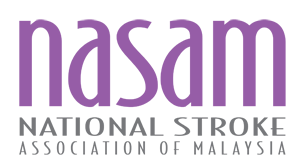STROKE FAQs
![]()
Stroke (also known as cerebrovascular disease) occurs when a blood vessel that carries oxygen and nutrients to the brain is either blocked by a clot or bursts. When that happens, part of the brain cannot get the blood and oxygen it needs, so it starts to die.
The extent and location of the brain cell damage determines the severity of the stroke, which can range from minimal to catastrophic. Because different areas of the brain control different functions, the specific effects of a particular stroke depend on which area of the brain is injured. A small stroke in a critical area of the brain can be permanently disabling.
Because brain cells do not regenerate, damage to the nerve cells is permanent. Millions of brain cells die each minute a stroke is untreated. Ruptured blood vessels cause hemorrhagic or bleeding strokes.
Reference: https://www.worldstrokecampaign.org/learn/stroke-facts.html
When a stroke happens, you should BE FAST to look out for the signs and symptoms of stroke:

There are two types of stroke caused by an isolated blood vessel that hampers blood flow to the brain:
- Where the vessel gets clogged within – Ischemic Stroke
- Where the vessel ruptures, causing blood to leak into the brain – Haemorrhagic Stroke
Reference: https://www.worldstrokecampaign.org/learn/stroke-facts.html
There are 6 new cases of stroke that occur every hour in Malaysia. Approximately 52,000 Malaysians suffer from strokes annually.
Reference: National Stroke Association (NASAM). http://www.nasam.org
The brain is an extremely complex organ that controls various body functions. If a stroke occurs and blood flow cannot reach the region that controls a particular body function, that part of the body won’t work as it should.
If the stroke occurs toward the back of the brain, for instance, it’s likely that some disability involving vision will result. The effects of a stroke depend primarily on the location of the obstruction and the extent of brain tissue affected.
The effects of a stroke depend on several factors, including the location of the obstruction and how much brain tissue is affected. However, because one side of the brain controls the opposite side of the body, a stroke affecting one side will result in neurological complications on the side of the body it affects.
Left Brain
If the stroke occurs in the left side of the brain, the right side of the body will be affected, producing some or all of the following:
- Paralysis on the right side of the body
- Speech/language problems
- Individual’s behaviour is slow and cautious
- Memory loss
Right Brain
If the stroke occurs in the right side of the brain, the left side of the body will be affected, producing some or all of the following:
- Paralysis on the left side of the body
- Vision problems
- Individual’s behaviour is quick and overly curious
- Memory loss
Your Age
The largest number of people who have strokes are aged over 55 and the risk increases as you get older. This is because our arteries naturally become narrower and harder as we get older.
Medical conditions
Certain medical conditions can increase your risk of stroke. These include:
- High blood pressure
- Diabetes
- Atrial fibrillation
- High cholesterol
An important way to reduce your risk of stroke is to find out if you have any of these conditions and work with your doctor to manage them.
Lifestyle Factors
The way we live has a big impact on our risk of stroke. Things like smoking, drinking too much alcohol, being overweight and eating unhealthy foods can damage your blood vessels, increase your blood pressure and make your blood more likely to clot. There are lots of simple changes you can make to your lifestyle that can reduce your risk of stroke.
Family History
If a close relative (parent, grandparent, brother or sister) has had a stroke, your risk is likely to be higher.
Your Ethnicity
If you are of South Asian (Indian, Pakistani, Bangladeshi, Nepalase, Sri Lankan) origins, or from an African or Caribbean background, you are at a higher risk of stroke than other people in the UK. People in these groups can be more likely to have conditions like diabetes or high blood pressure which can raise your stroke risk.
https://www.stroke.org.uk/what-is-stroke/are-you-at-risk-of-stroke
If you have ischaemic stroke, you may be treated with a clot-dissolving medicine. The earlier the treatment, the better the outcome.
An endovascular procedure or mechanical thrombectomy is another option to remove a clot in eligible patients with a large vessel occlusion.
In this procedure, doctors use a wire-cage device called a stent retriever. They thread a catheter through an artery in the groin up to the blocked artery in the brain. The stent opens and grabs the clot. Special suction tubes may also remove the clot.
The procedure:
- Should be done within six hours of onset of acute stroke symptoms
- Can benefit patients under certain conditions if done even within 24 hours of onset
- Should include clot-dissolving medicine in eligible patients
https://www.strokeassociation.org/en/about-stroke/treatment/ischemic-stroke-treatment
a) Cut down on alcohol
Regularly drinking too much alcohol raises your risk of a stroke. In the UK, the government advises that to keep health risks low, it’s best to drink no more than 14 units a week, and to spread the units over the week. The limit is the same for men and women.
b) Stop smoking
Smoking doubles your risk of dying from a stroke. But the minute you quit, your risk of a stroke starts to drop right away. Stopping smoking could be one of the best things you ever do for your health, and there is lots of help available.
c) Reduce your waist size
Being overweight makes you over 20% more likely to have a stroke, and your risk goes up with your weight. Being obese puts your risk of a stroke up by 64%. Extra weight affects your body in many ways, such as raising the risk of high blood pressure and type 2 diabetes, which are both linked to stroke. If your waist is larger than 94cm (37 inches) in men, or 80cm (31.5 inches) in women you could be overweight.
BMI, or body mass index, shows whether you are the right weight for your height. Your BMI should be below 25, although people from African/Caribbean and South Asian ethnic groups should aim for a lower BMI of 23. This is because people in these groups are more likely to have conditions like diabetes and high blood pressure.
If you are advised to lose some weight or you want to make some healthy lifestyle changes, you don’t have to do it alone. There are some great resources online such as NHS One You and apps for stopping smoking. Your local pharmacist may be able to help. Your family and friends could give support by encouraging you, or joining in with your healthy eating and exercise plans.
d) Eat healthily
- Reduce salt
- Reduce sugar
- Eat less fat
- Boost your fibre
- Balance your die
e) Be as active as you can
Being physically active can help to reduce your risk of a stroke. Moving around can also help your emotional wellbeing by releasing chemicals into your brain that make you feel better. If you are able to increase your levels of physical activity, it can make a difference to your health and wellbeing. For some people, staying active could mean walking around the room, and for others it means joining a fitness class or doing some gardening.
https://www.stroke.org.uk/sites/default/files/reduce_your_risk_of_stroke_v2_april_2019.pdf



